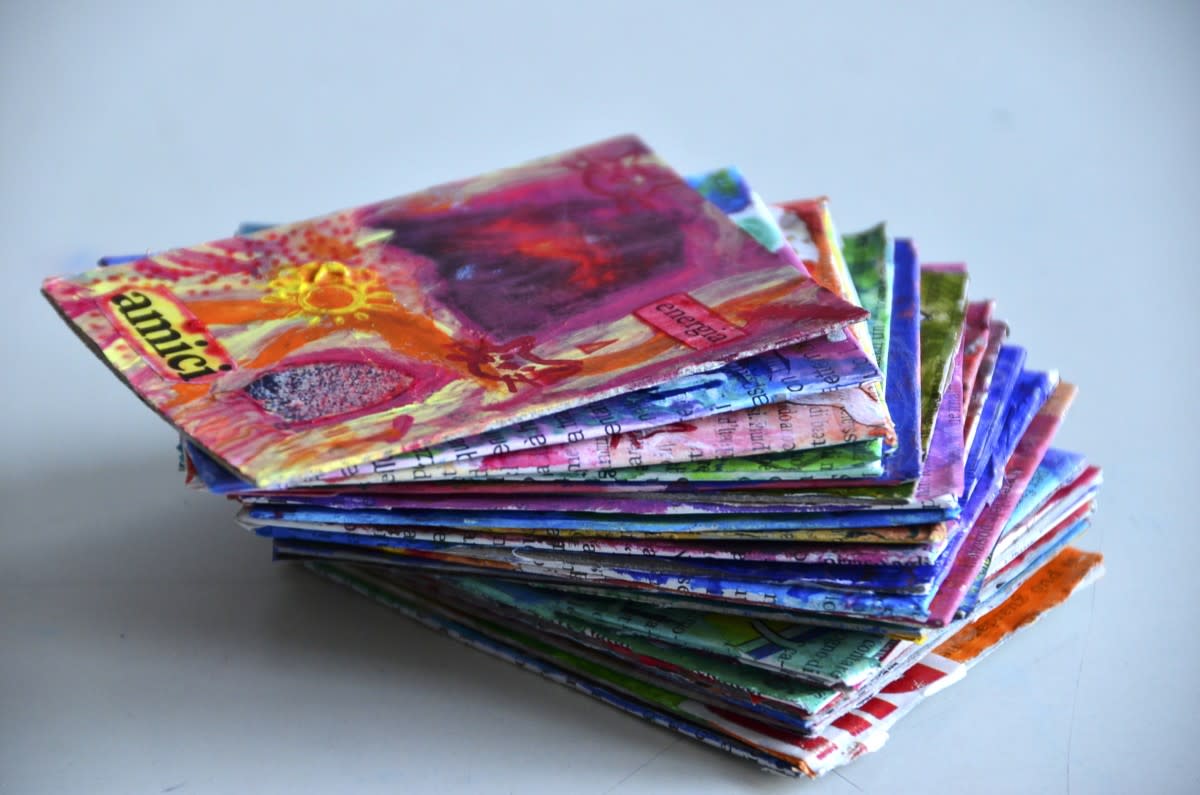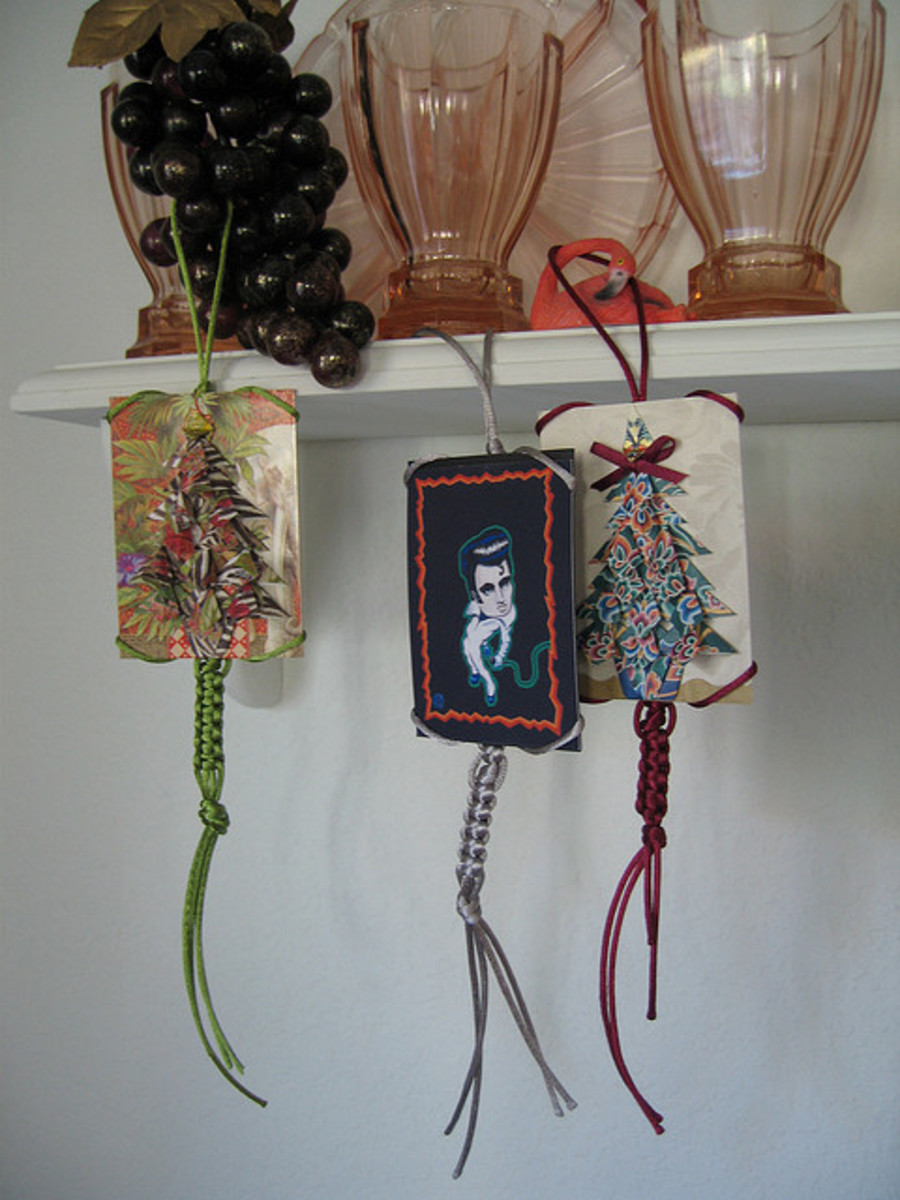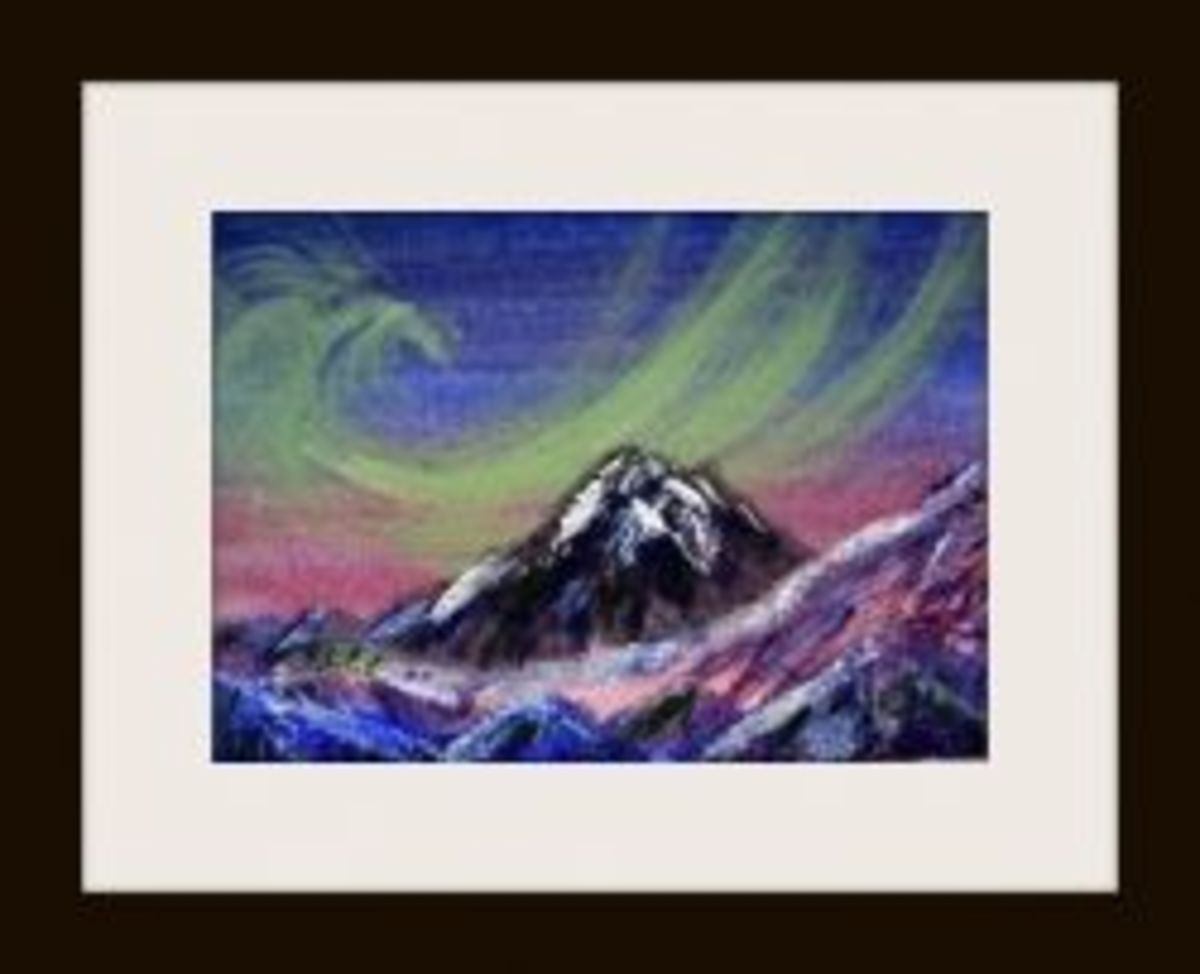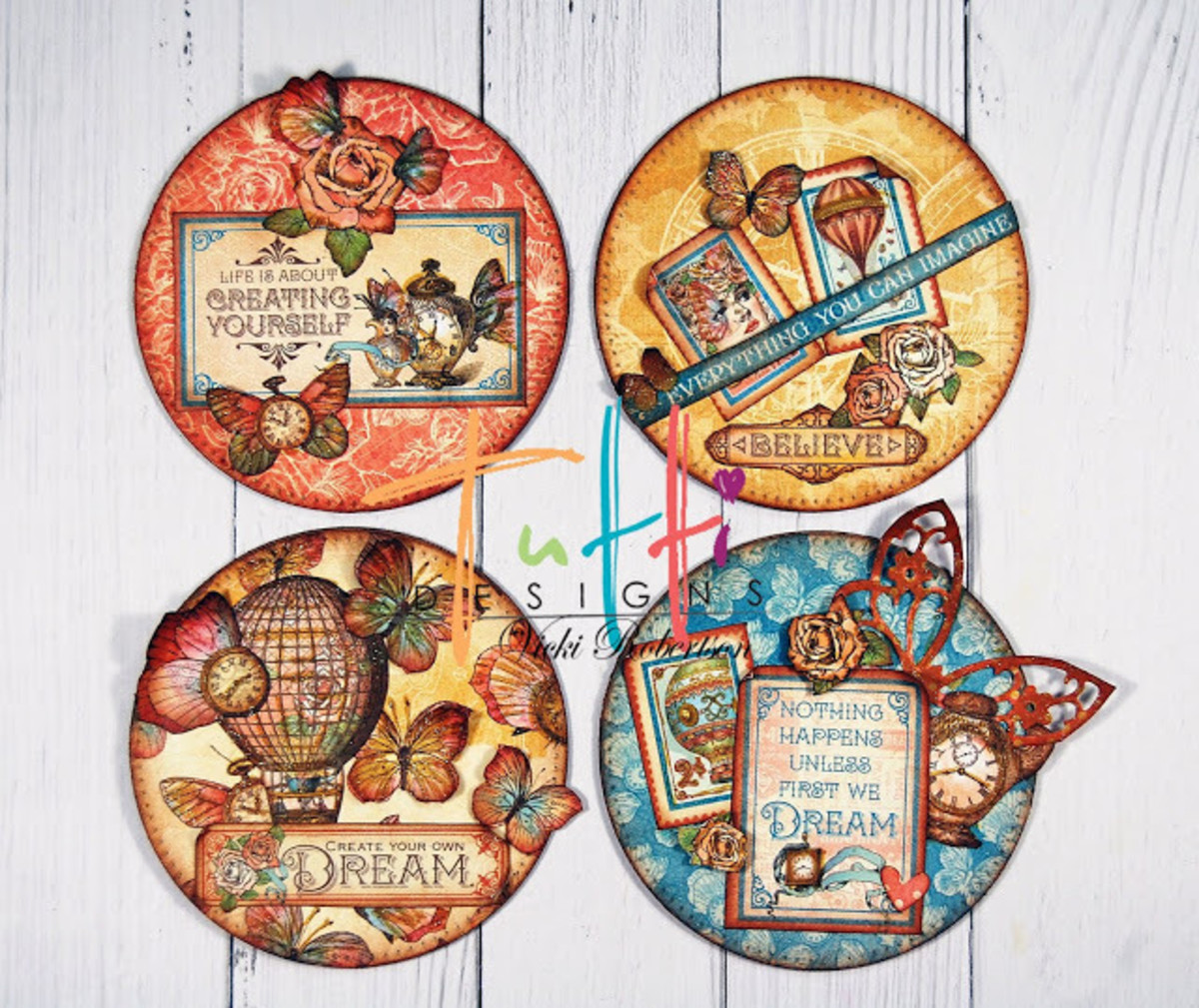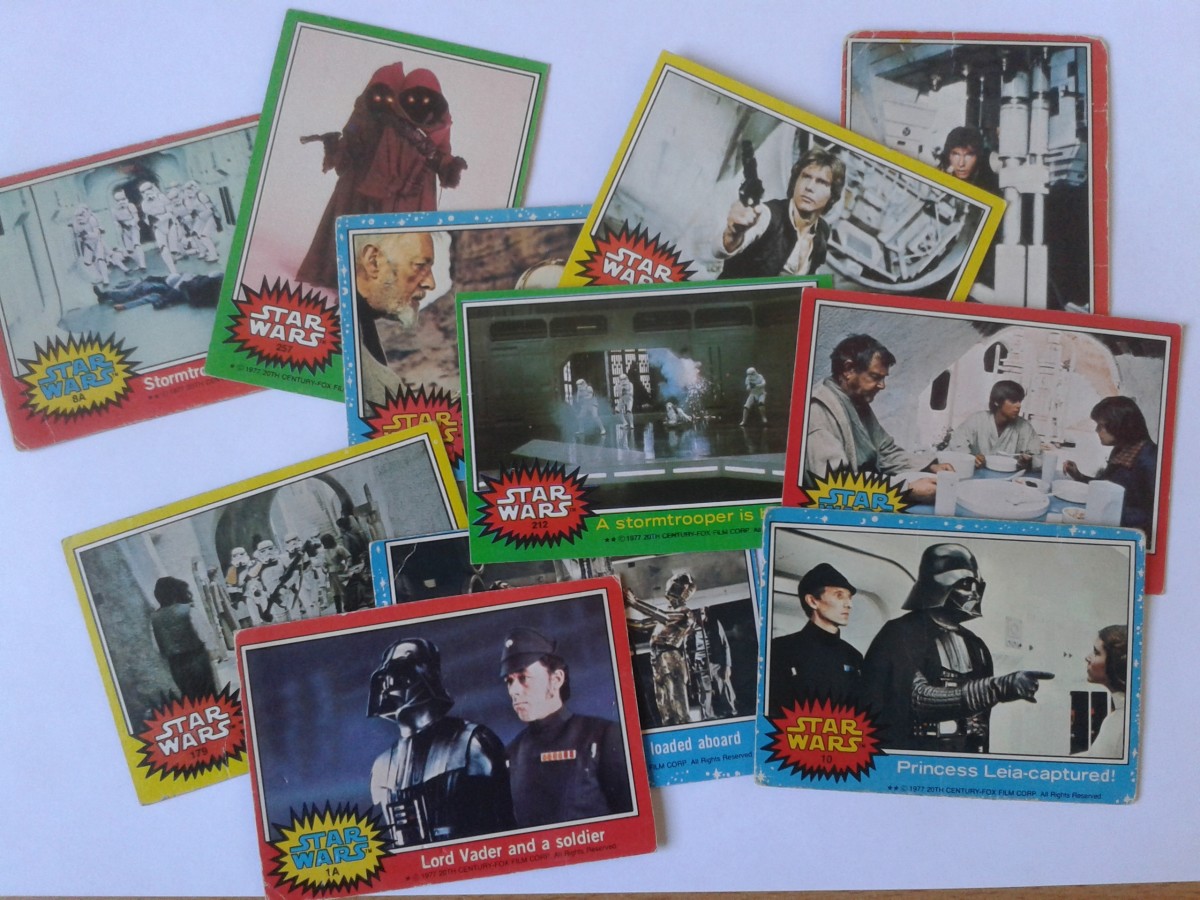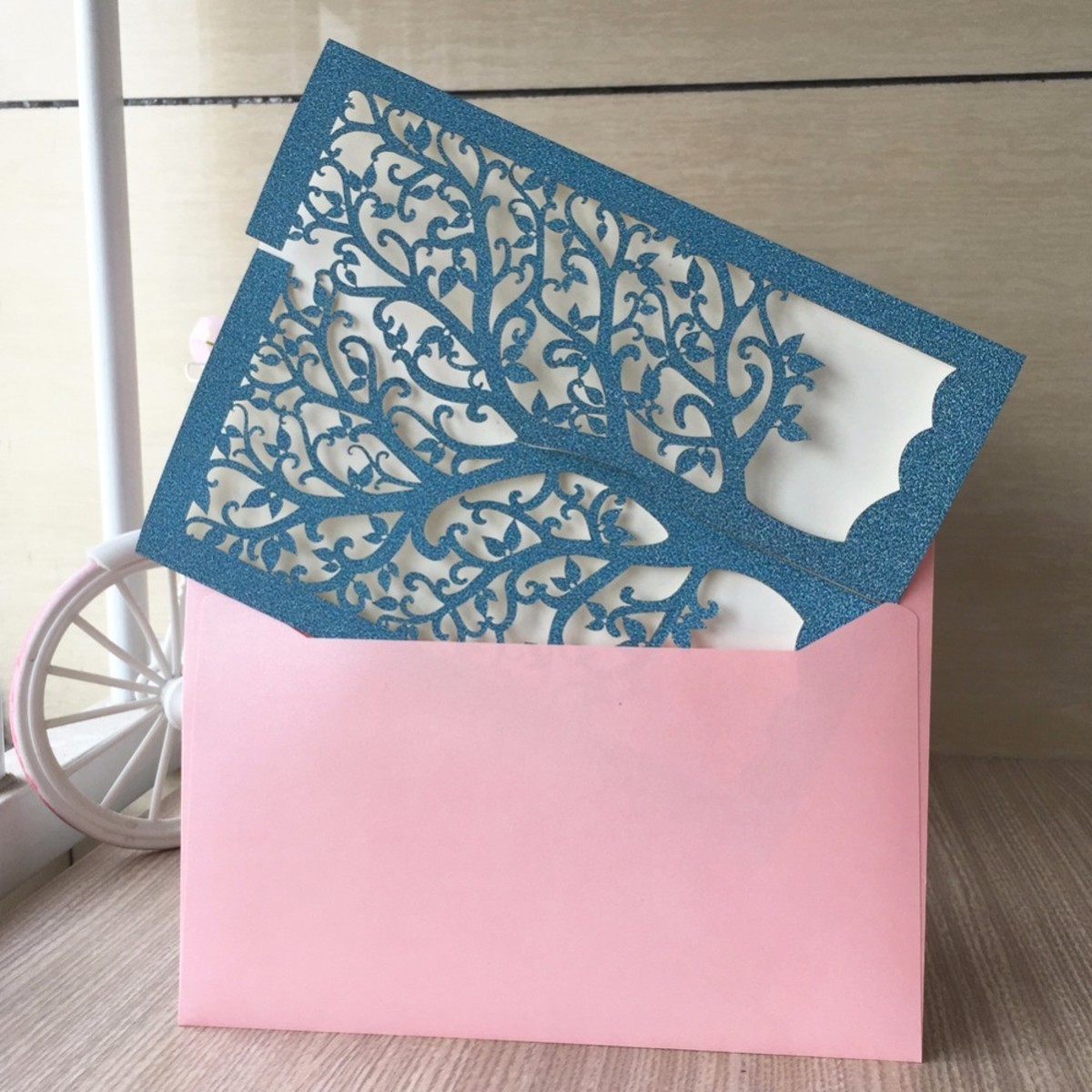ACEO Cards - Miniature Art - Start Collecting

Art Cards, Editions & Originals
ACEO & ATC both mean Artist Trading Cards.
ACEO stands for "Art Cards, Editions and Originals." Also referred to as ATC (Artist Trading Cards), these are miniature works of art that are the size of a playing card or baseball card, 2.5 x 3.5 inches (64 x 89mm). They are small enough to hold in your hand or put in your pocket. Like jewels, there is an intimacy and sense of wonder in holding an ATC/ACEO in your hand and looking at it.
Artist cards are made, traded, and collected worldwide. The difference between ACEOs and ATC's is that the former can be sold. On the other hand, ATCs are never sold.
I think of ATCs as miniature art cards traded between artists for free. In other words, no money changes hands. ACEOs include both artists and non artists alike and in this way, everyone can join in the fun of exchanging cards and the artwork can be seen throughout the world.
Miniature artist "cards" were fashionable in the 16th Century, and these were sold and not simply traded. Those who could afford them would pay artists to make them. In a manner of speaking, they were the first wallet photos. Men might carry miniatures of their girlfriends, wives or mistresses while traveling or away, or a woman might keep a one of her husband while away.
In the 1700s, tradesmen began to use cards to advertise their services. In fact, one of the pastimes in Victorian England was collecting these small, illustrated, black and white advertising cards. In the early 1800s, color lithography was being explored and by the late 1800s, trade cards in Europe and in America became a major way of advertising. Food, tobacco, and household items were some of the products heavily advertised. During the early 1900s, as magazines and other methods of advertising in color became more cost effect, the use and popularity in trade cards began to fade.
These cards were often thought of as altered art, and in this way they were very similar to the work of artists Joseph Cornell, Kurt Schwitters, and others. Joseph Cornell (1903-73) made artistic poetry from his assemblages of Victorian bric-Ã -brac combined with photos or a bit of text, housed in a type of shadowbox. Dadaist Kurt Schwitters (1887-1948) was fascinated with discarded things. Macel DuChamp (1887-1968) created many assembled compositions with found objects, at times including sounds. And in 1916, he began sending artsy postcards to his neighbors.
In the 50s, American artist Ray Johnson began sending out collaged, hand-stamped letters to a large network of people, including Andy Warhol and James Barr of the Museum of Modern Art. He loved collaboration and preferred giving his art away in this manner instead of selling it. Soon a group of postal artists formed, creating Mail Art and sending it all over the world. It became known as the New York Correspondence School of Art, with Ray Johnson at the center.
It is said that the first mail art was created in 49 BC by Cleopatra when she had herself delivered to Julius Caesar in a rolled-up carpet.
Mail Art, also known as Correspondence Art or Postal Art, used the postage system as a medium to exchange ephemera as a personal artform. It was usually in the shape of a postcard which had been added to by being collaged, written upon, drawn on, painted on and even punctured. Any technique and media could be used, the stipulation being that it had to pass postal regulations and go by mail. This art form evolved in the late 50s and early 60s and still continues. It was influenced by the Dada, Surrealism and Fluxus movements and was certainly helped by the Conceptual art scene in the 60s and 70s.
Mail art and other types of altered art exchanges were quite popular with artists in the the 80s and early 90s but eventually things started to quiet down.
Then, In 1996 Swiss artist M. Vanci Stirnemann made a brilliant decision which brought the concept of altered art in the form of artist trading cards to the forefront of both the art and craft communities. What occurred was this: M. Vanci Stirnemann wanted to make a catalogue to document his activities with other artists. Because printing costs were extremely high, he created all 1,200 cards by hand.
Then, in 1997, Stirnemann exhibited his handmade cards and, at the same time, he asked a large group of artists to create cards as well, so that on the final day of the art exhibit, he could trade his cards with them. It is said that M. Vanci Stirnemann got the idea for trading these miniature cards by watching enthusiastic sports fans trading cards at a hockey game.
Needless to say, the last day of the exhibition was a huge success. Stirnemann decided not to sell any of the cards exhibited but instead to trade them all. All visitors and walk-ins were encouraged to make cards also, and these were also traded with Stirnemann and the other artists at the closing reception. Canadian artist Chuck Stake (aka Don Mable) was one of the attendees/participants. He was extremely enthusiastic about the ATCs and collaborated with Stirnemann in 2000 in an exhibition in Calgary, Canada. Eighty artists from around the world participated.
With the help of the internet, the interest in ATCs spread like wildfire and there's been a huge resurgence in many forms of altered art, including mail art (which just happens to include ATCs when they are 2.5 x 3.5 inches and they are mailed.)
In October of 2004, Colorado artist Lisa Luree (aka bone*diva) started the ACEO group on eBay in response to the prohibition with selling that was associated with typical ATCs (Artist Trading Cards), and in part to make these cards available to collectors. She also organized to bring artists together and market the acronym ACEO, which means "Art Cards, Editions and Originals." Artists from around the world began selling their art trading cards. When I last looked, over 6,000 artists were selling on eBay and that number is growing daily. If you are thinking about collecting Artist Trading Cards, NOW is the time!
ACEO's are 2 1/2" by 3 1/2" art cards. They come in Sport Trading Card size and make unique and unusual gifts. Many people collect them, especially if they like a particular artist and cannot afford full sized originals! Why pay an exorbitant amount of money on one piece of art from an artist when you can get several pieces of art from several artists?!
Regarding the financial aspects of this art, they are truly a great investment. If you check with eBay, a number of these miniature pieces of art are going for more than many full size paintings or drawings! There is demand! A great deal of demand! Successful ACEO artists are getting anywhere from $15 to hundreds of dollars for one little 2 1/2" x 3 1/2 piece of art! I recently saw one of these miniature art cards listed on eBay for $3500! I didn't see any buyers, but who knows what the future will bring?!
You may not know who will be the next Van Gogh, Picasso, Renoir, etc, but by purchasing these ACEOs, you just may hit the nail on the head! There are many excellent artists making ACEOs whose artwork continues to increase in value. Maybe you would like to purchase an artwork by a specific artist but you cannot afford to spend thousands of dollars on it, but you could easily purchase an AECO from them. Most ACEOs range from about $5 to $15, but prices are always rising. It's time to begin collecting!
ACEO Card (shown above) "Show Me Yours" © 2008 Charlene Murray Zaloukal
You can visit her Squidoo Art Lenses here: CMZ Art and Rustic Goth
All rights reserved
ACEOs Currently Being Auctioned on eBay - This Will Give You an Idea About How Much These Cards are Going For
LLisa Luree (aka bone*diva) started the ACEO group on eBay in response to the prohibition with selling that was associated with typical ATCs (Artist Trading Cards), and in part to make these cards available to collectors. This auction features her cards and other miniature artworks.

ACEOs Are a Great Way to Give to Charity!
ACEOs are a great way to raise funds for charities and for the community. These miniature art treasures have been used to raise funds to help fight Breast Cancer, Multiple Sclerosis, and Lung Disease, as well as to raise funds for animal rescue and shelter. And that's just the tip of the iceberg.
A Kansas City comic book artist by the name of Alonzo Washington creates trading cards that focus on America's Forgotten Children. In this way, he helps to keep the fate of these missing children in the public view. Also, in view of our current economic conditions, many artists and art groups are joining together to raise funds for school programs. There are so many charities we can help.
For example, look at the animals. Today so many are on the brink of extinction, including the African primates, the black rhino, the Iberian lynx, and the Tamil tigers of Sri Lanka. Even the friendly and intelligent dolphin population is facing extinction.
Please reach out and make a difference in the world and donate to someone or something who needs it. ACEO's provide one very good way in which to give.
ACEO Card (shown above) © 2008 Richard McDuff
Have You thought of giving ACEO's as Gifts or as Stocking stuffers?
Give Art Cards as Gifts for Bithdays and for Other Special Occasions
Art Cards make great gifts. They are growing in popularity, and if you check on Ebay they are going for more money than conventional sized Art. These are HOT items right now, and you can get almost any kind of art you can think of! There is Goth art, fairy art, whimsical art, patriotic art, etc. The list goes on and on! So many people collect ACEOs! This stuff is so incredibly popular it is mind boggling!
How To Store and Display Your Card Collections
You'll Want to care for Your Cards, as Well as Show Them to Others
You can get Pocket Artist Trading Card Binder Pages, which fit any standard 3 ring binder. I've also seen ATC card binders with 8 and 9 cards to a sheet.There's a different kind of storage book called "ATC Queens Court Album" with custom designed pocket pages. You can see it HERE. You can also buy small frames and put them on the wall, or you can buy small table easels for them. Clear acrylic stands are also available. You can also have them matted or buy a precut mat for them. I've seen mats that come precut and hold one, two, and four cards. Of course you can always have the matboard* cut for you and then have them framed. You can get many of these supplies from hobby shop or from the mail order sources I have listed.
Other suggestions are to place your cards in a basket and put it in a prominent area of your home so that guests can look through them. Purchasing a storage box or a revolving holder is another option.
Sherry Venegas (paperfacets) creates "Cordelettes," which are a great method of displaying ATCs/ACEOs. Here's the link to her lens: ACEO Cordelette Hanger for Card Display.
As collecting ATCs and ACEOs are becoming more and more popular, artists are coming up with their own solutions. Collectors and artists alike are coming up with ingenious ways of storing and displaying these miniature jewels.
*If you are using matboard, always buy archival acid free matboard to preserve your ACETs.

